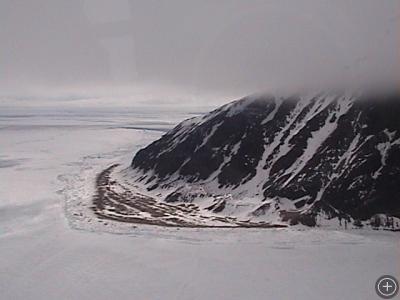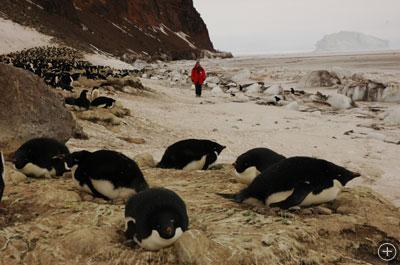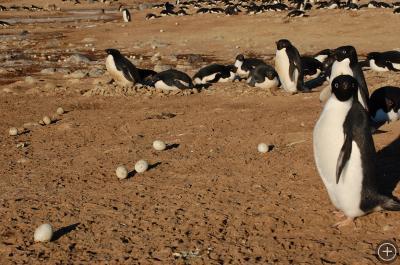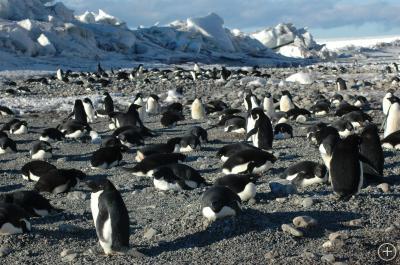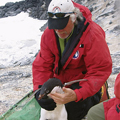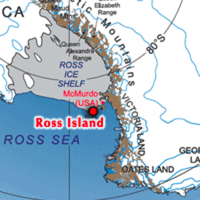Beaufort Chaos
CAPE ROYDS, ROSS ISLAND, ANTARCTICA– We’ve made three trips, by helicopter, to Beaufort Island this season. Usually we can’t do this until the end of the season, because the McMurdo helos don’t fly over open water and a ship is not available until the end. It’s a 40 minute helo ride and a 6 hour boat ride. This year, though, fast ice extends out to Beaufort, so we can go by helo. Perhaps I’ll report on the Beaufort boat ride later, but maybe not, because the fast ice is so extensive and thick, the icebreaker likely won’t be available for us to make the trip. It will be breaking ice so that a cargo ship can resupply McMurdo Station.
The reason we go to Beaufort is that it appears to be the true “penguin pump” in this cluster of colonies in the southern Ross Sea. We want to confirm this. The colony at Cape Crozier produces lots of chicks, like Beaufort, but it has a huge area for expansion, if the penguins are up to that. Mostly they are not, because more and more penguins in one area leads to more competition for food in nearby waters. To avoid that, young Crozier penguins might want to find a territory elsewhere, or not, like at Cape Bird.
The Beaufort colony also regularly produces a lot of chicks, but until recently there was no room for the young prebreeders that result from that to find a spot, except in very poor habitat (see below). That’s why young Crozier birds didn’t want to move there either. The Beaufort breeding area has been hemmed in by vertical cliffs behind, and open ocean the other way. Penguins would be everywhere where they possibly could be, wall-to-wall so to speak. Penguins that didn’t want to tussle for a spot definitely would show up elsewhere like Cape Royds: lots of space there and no competition for food. We know this because we’ve been making the icebreaker trips almost every year since 1996 in order to band a bunch of chicks at Beaufort. In later years, we see these banded birds at Beaufort but in disproportionate numbers we see them at the other colonies, too…until recently.
Here’s a shot of Beaufort from the air taken in 2001; west is towards the background. You can see the ‘shelf’ of gravel on which the colony nestles, hemmed in by precipitous cliffs in the back, snow fields to the west, and the ocean. Penguins are everywhere that there is level ground and no ice (there are about 60,000 nests crammed into this area). The west end of the colony is hemmed in by ice fields (see next photo).
Yes, disproportionate numbers of penguins raised at Beaufort have been going elsewhere until a few years ago when global climate change began to kick in around here. Then, with slightly warmer temperatures the snow and ice fields on Beaufort began to rapidly retreat [sound familiar? Hey, I drove up to see Glacier National Park this past summer to see the glaciers before they are gone….maybe by 2015 they say.] This warming caused the ice to retreat at Beaufort also, thus exposing lots of terrain with lots of small pebbles, ideal for nests.
Here is a picture of penguins setting up territories at the west periphery of the colony that until recently, 2001 (see aerial Beaufort photo) was covered (probably for the last 20,000 years) by snow and ice. These penguins were not here in 2001. So, you see, that bad-ee, Global Climate Change, can be “good” sometimes!
Well, there are so many penguins trying to find a nest at Beaufort, and so little space and not enough rocks, that, actually, Global Climate Change is not happening fast enough!! As a result, many penguins are nesting in suboptimal habitat and more than likely they will lose their nests and its eggs. This will force them to be more prudent next season. Either they will set up nests at the west end of Beaufort (see photo above)…the most likely….or many will seek out places like Cape Royds, where lots of stones are to be had along with lots of space (and usually open water; see next blog dispatch).
These penguins are nesting in scoops in the guano with almost no stones. All of the stones have been used up by other penguins! More than likely their eggs will roll out of the nest and, in fact, on our next visit following this one, we found eggs EVERYWHERE.
There are well over 30 whole eggs in this picture that have rolled out of nests. There simply were not enough rocks for the penguins to build the protective “basket” to hold them.
Still lots of nests had eggs but lots had rolled away– so many that the skuas had too many to eat! The other thing that happens when a penguin has a scoop but no stones, is that it fills up with water. That’s bad for eggs and chicks.
Here are penguins who built nests, and laid eggs, in a depression that initially was dry but now is filled with melt water. There was no room for them on high ground. Yes, there are eggs underneath these birds!! This is a demonstration of how staunch penguins are, in spite of adversity. They won’t give up until the conditions become impossible. These are impossible conditions, and yes, these penguins gave up!
Here are a bunch of penguins that have built their nests on a nice sandy beach (above). How idyllic! It’s the kind of place that people would hang out; all we need are some palm trees. However, when all that ice in the background eventually melts later in the summer, then the sea is going to come pouring in, waves crashing, to wash the penguins’ feet, but also their eggs and chicks, too. These penguins, too, next season will be looking elsewhere for making a nest!
So you see, and I know you’ve been told this before, Nature works in strange ways. It takes some adversity to convince penguins, and people, to alter their behavior…that is, to stay in higher or safer ground!!!! This is going to be the same for people beginning very soon, as global climate change REALLY gets going. I hear that insurance companies no longer are insuring houses on the US Gulf Coast, owing to increasing numbers of hurricanes and rising sea level. See, if the insurance companies can’t afford this, neither can the rest of us. Where are all those Floridians going to be living? In Georgia, I guess. Penguin Insurance Companies, to stay in business, would not insure these penguins’ homes shown above. (Penguins don’t get government bailouts for bad decisions.)

 No comments
No comments 